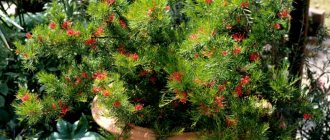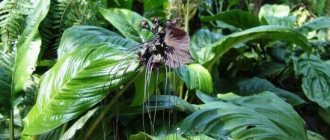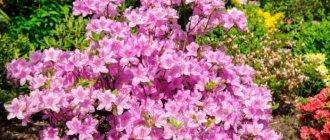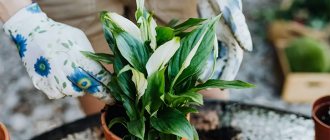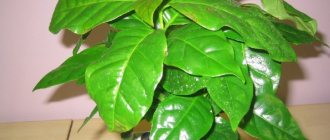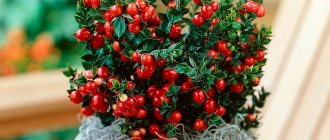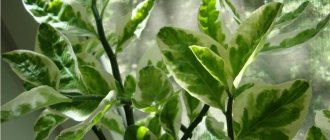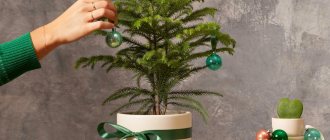Biological certificate
The Sansevieria plant is an evergreen herbaceous perennial belonging to the Asparagus family. In its natural environment, it is found in Asia, Africa and Madagascar, and is also widespread as a houseplant.
Sansevieria is called differently in different countries. Mother-in-law's tongue or women's tongue, the sword of St. George, the tiger's tail and the pasha's sword are not all the names of this amazing plant. The name of the genus Sansevieria is given in honor of the Italian scientist and inventor Raimondo di Sangro (1710–1771), Prince of San Severo (San Severo is a commune in Italy).
When and how does it bloom
The flowering of Sansevieria cylindrical goes almost unnoticed. The inflorescences are brush-shaped and are located on a long and erect peduncle. It is the same in length as the leaves of the flower, but sometimes it is longer. Small flowers with white-cream petals are tubular in shape. Some varieties have pale pink flowers.
This is interesting: How to reanimate an orchid: options for restoring and reanimating a flower
The bush blooms for only about a week. Already 5-8 days after the buds open, they begin to close back and fall off.
Blooming sansevieria
Types and description
In total, there are about 200 species belonging to the genus Sansevieria, which in turn are divided into three subspecies:
- Sansevieria
- Dracomima
- Cephalantha
Photos of Sansevieria taken in different parts of the world show that it is not always a plant with long leaves and no flowers. Sometimes it is a succulent desert plant, sometimes a tropical plant with thin foliage. Many Sansevierias have one feature - the foliage, as a rule, is located in the form of a rosette around the growing point.
Sansevierias come from regions with arid climates and have tough, thick leaves to store moisture. They have special cuticles to reduce moisture loss and a cylindrical, shorter leaf shape.
Subtropical Sansevierias do not need such “accessories”; they have softer, wider and longer leaves.
Diseases and pests
The main pests of this variety are:
- Spider mite . The leaves turn yellow and white spots appear on them. For prevention, wiping with a damp sponge is used; for treatment, the insectoacaricide Actellik is used.
- Thrips . The leaf blade becomes grayish-brown, and eggs laid by the pest are visible on the underside. Insecticides are used for treatment.
- Mealybug . The foliage becomes distorted, turns yellow and dies. If the pest colony is small, it can be removed by wiping the leaves with a damp cloth. In case of severe damage, karbofos is used.
The most common diseases and care errors are:
- Brown spots and dried areas are symptoms of anthracnose. The disease develops due to waterlogging and is treated with a fungicide solution.
- Yellowness and softening of the leaves at the base is another sign of waterlogging. All affected shoots must be removed and the plant transplanted into fresh soil.
- Uniformly withered leaves and their death may indicate an excessive drop in temperature and dry soil. Sansevieria must be moved to a warm place and all damaged areas removed.
Flowers
The description of a plant flower also cannot be the same for all species. Typically, the flowers are greenish-white, pink, lilac-red and brown.
Sansevieria carnea, growing in Japan and China, will surprise you with its delicate purple small flowers, Sansevieria cylindrica is characterized by a long branch growing from a rosette with many pale flowers, and the flowers of the huge Sansevieria kirkii, growing in Tanzania, can be compared to the hair of a brownie or a clown. The fruits are red and orange berries.
In nature, Sansevieria flowers are pollinated by moths, but both flowering and fruiting are unstable, and few seeds are produced. Seeds are not the easiest way to propagate this plant at home.
Reproduction
Sansevieria three-lane
Sansevierias are propagated in spring or summer by vegetative methods - by dividing rhizomes or leaf cuttings.
To preserve their characteristics, variegated and some other varieties should be propagated only by dividing the rhizomes. When propagated by leaf cuttings, the characteristics of the variety are often lost and young plants of a natural appearance grow and lose their variegation.
The rhizome is divided with a sharp knife so that each division has a growing point and a rosette of leaves. The delenki are placed in separate pots, the wounds sprinkled with coal, in a sandy substrate. At first, watering is very limited. After rooting, several new shoots and new rosettes of leaves are formed from each piece of rhizome.
To propagate by leaf cuttings, a healthy leaf is cut transversely into 5 cm fragments, the sections are dried in air, then the lower cut is treated with Kornevin and buried 1-2 cm in sterile, slightly damp sand or a mixture of sand and peat. There is no need to put it in a greenhouse; high air humidity can cause rot. The light is bright, diffused, temperature is about +20+25°C. Rooting lasts approximately 6-8 weeks, after which young shoots begin to grow.
Use in the world
In Africa, ropes are made from the leaves of the plant. It is also used as a medicine with antiseptic properties. In addition, it is possible to make a bow string from the leaves.
Sansevieria is considered one of the most successful plants for growing at home, especially in the bedroom, due to its ability to release oxygen at night.
In Asia, the plant is revered and given as a gift for various holidays. Perhaps it was precisely because of its healing properties and ability to purify the air, which people who lived in ancient times knew about. It is not recommended to keep the flower within reach of small children. Despite its beneficial qualities, Sansevieria leaves are poisonous.
In Barbados, Sansevieria is also often called the “money plant”, in the belief that the person who has it will always have money.
Sansevieria can be found in many foreign films as decoration. The plant is also loved by people who are interested in Feng Shui.
Benefits and harms
- In addition to its extraordinary appearance and extreme unpretentiousness, Sansevieria is also endowed with a lot of advantages:
- ability to release large amounts of oxygen;
- antibacterial effect;
- improving the quality of immunity and accelerating metabolism;
- neutralization of harmful fumes in the room (for example, from paint);
- the juice of this plant is often used in the treatment of diseases such as cystitis, inflammation of the appendages, otitis media and many others.
In addition, it is believed that the flower can cleanse the house of negative energy and absorb radiation from a computer or TV. According to Feng Shui, Sansevieria is able to promote the assimilation of information and absorb manifestations of anger and rudeness.
- But, having so many positive qualities, this flower also implies some limitations:
- when using sansevieria for treatment, extreme caution must be taken, since this plant contains the toxic substance saponin;
- the energy of this flower is considered too strong for children's rooms or playrooms;
- Sansevieria is not displayed in the spouses’ bedroom - it is believed that this leads to frequent quarrels; the best place for a pot with a plant would be an office or living room.
Home care
Residents of countries with temperate climates are more familiar with Sansevieria Three-Stripe. In its natural environment it grows in western Central Africa. Leaf length is 70-90 cm (under optimal conditions it can reach 2 meters), width is 5-6 cm.
Particular attention should be paid to how to water the flower. Both the quality of the water (non-chlorinated filtered or distilled water is suitable) and quantity are important. The plant should be watered only when the top layer of soil becomes dry. It is important that water does not get into the center of the outlet.
Overwatering a succulent may cause the roots to rot. In this case, the plant needs to be removed from the pot, cleaned of soil, cut off rotten roots, treated with fungicide and planted in fresh soil. In cold weather, watering should be reduced.
Sansevieria leaves collect quite a lot of dust, but it can be easily removed with a damp cloth. Water procedures from a spray bottle will also not be superfluous.
If there is excess air humidity, the foliage may be susceptible to the development of fungus. Affected leaves need to be cut off and the plant placed in a place with more favorable conditions.
To care for a plant at home, it is not necessary to use fertilizers, but their application will be a useful addition to regular watering. Fertilizer for decorative foliage plants is perfect for these purposes.
Sansevieria is not very picky about temperature and tolerates even extreme heat well. It is recommended that the night temperature be lower than the day temperature and not lower than 16 degrees. The optimal daily temperature maximum is 28 degrees.
Good daylight will be a plus for the plant to delight you with long and bright leaves. It is worth considering the fact that the more variegated the feathers of Sansevieria, the more light it needs to maintain the contrast of the stripes on the leaves.
Sansevieria is best propagated when new shoots appear, preferably in the spring. You need to remove the plant from the pot, divide the rhizome with a knife and plant each part in its own pot, preferably a thick one, while not forgetting about drainage.
When dividing by leaves, the leaf is cut into several parts, dried for about two days, and planted vertically in damp sand, peat or vermiculite to a depth of about 2 cm.
This unpretentious, green and oxygen-giving plant is perfect for adding freshness and beauty to your home. It is unpretentious, so it is suitable even for novice plant growers and, with proper care in indoor conditions, will delight with green, juicy leaves and, although rarely, small delicate light flowers.
Varieties of Sansevieria
We offer a close acquaintance with some types of Sansevieria.
Duneri Grandis
One of the varieties of “mother-in-law’s tongue” is Sansevieria Duneri. Its homeland is the lands of West Africa.
This species is characterized by the presence of approximately twenty flat-shaped leaves that are arranged evenly. Their height can reach one meter and width – three centimeters. The color is bright green. There are transverse stripes on the surface of the plates, but they are blurred and almost invisible. The flowers are a pleasant white color, with an alluring aroma of lilac.
This plant can improve immunity and restore proper metabolism.
Sansevieria Grandis
This species is also called Sansevieria major. This variety is characterized by very large, thick and wide leaves, the height of which is not too large. An adult plate reaches a maximum of half a meter. The color of the leaves is bright green. There are also zigzag stripes that are located in the transverse direction. The edges of the leaves have a neat red edging. Inflorescences are white-green. They form a racemose shape.
Sansevieria three-lane
This type of plant is one of the most common ones grown in indoor pots.
One rosette of sansevieria trifasciata has no more than six leaves, colored dark green. On their surface there are rather light stripes located in the transverse direction. The height of the leaves reaches one and a half meters, the width is up to ten centimeters. The shape is flat, smooth, has a peculiar narrowing towards the upper part, and at the end there is a spike.
For this type of plant, the lighting in which it grows is important, because the color of the stripes depends on this factor. In the presence of bright light, the leaves become brightly colored. Otherwise, the color becomes dark green, and the stripes are rather weakly expressed, without any clarity.
Photos of the main types of three-lane sansevieria:
- Laurenti. This variety has vertically growing leaves. Sansevieria Laurenti has plates on the edges with a clearly yellow border, which distinguishes it from other species.
- Sansevieria Futura Superba. This is a new variety that has won the hearts of many gardeners in a fairly short time. The plant has wide green leaves, not very large in size. Each plate of Sansevieria Futura has a neat yellow stripe along the edge.
- Compact. The leaves are slightly thinner and smaller in size than Laurenti. The edging is quite thin and yellow. The center of the plate is very dark. Some leaves periodically curl to the sides, due to which this plant variety looks impressive and beautiful.
- Sansevieria Moonshine. Famous for having thin, smooth leaves. Their color is light, having a gray-greenish tint. Occasionally there is an inherent silvery tint. The shape of the plates is wavy.
Sansevieria Cylindrica
The variety sansevieria cylindrica was bred artificially from other species. It is characterized by the longest leaves, from which you can even weave various interesting compositions. To do this, just connect the plates together in any order you want, and wrap them on top with an elastic band, rope or even a bow.
This type of plant does not like direct sunlight, which can cause burns. The flower copes well with drafts, but is very susceptible to abundant watering. It is better not to water this plant at all than to allow the soil to become waterlogged, which will cause the root system to rot.
Sansevieria cylindrical needs constant feeding. Such procedures should begin in the spring and end at the beginning of the autumn; the rest of the time nothing needs to be done. Any complex mineral and organic substances are well suited as fertilizers; you can also use ready-made mixtures for feeding succulents. The proportions indicated on the packaging must be strictly observed.
The plant should be replanted into another pot no more often than once every three years. At the same time, do not forget to remove dried flower stalks. This crop is characterized by flowering on one leaf only once, so do not even try to wait for repeated bud formation.
After transplantation, it is necessary to maintain the previous location of the flower in the apartment, since adaptation to new conditions and new lighting does not always happen as we would like.
Easy propagation
Sansevieria cylindrica, which is shown in the photo, is easily propagated using leaves. Therefore, if for some reason the plate of your favorite plant has fallen off, do not worry, but use it for propagation.
The sheet should be cut into several pieces approximately five centimeters long. Leave all elements alone for 48 hours so that they dry properly. Prepare a small flower pot, and then pour into it a special substrate for this type of plant. Prepared planting material should be planted at a shallow depth. Make a so-called greenhouse, for which you cover the pot with ordinary cling film and leave it in a warm place with good lighting.
While the leaf is taking root, you should ventilate the mini-greenhouse daily and water it periodically as the soil dries out. In less than a month, the cut parts will form a full-fledged root system. It is at this time that you can safely transplant small flowers into separate small pots.
Low growing sansevieria
This type of plant was bred on the basis of the Laurenti variety by breeder Khan, and therefore received the name Sansevieria Hanni. This is a low-growing plant, the height of which does not exceed thirty centimeters.
Based on this species, such low-growing varieties were later developed as:
- Sansevieria Golden Honey. The flower is very similar to the previous type, only complemented by the presence of yellow stripes. The pattern on the surface of the plates may be in a chaotic order. Because of its color, this variety is called sansevieria with yellow edges. The plant is very popular among gardeners due to its rapid establishment and attractive appearance.
- Sansevieria Silver Honey. The name speaks for itself. The leaves have a gray-green tint. The stripes in the longitudinal direction are not clearly defined and have dark edges.
- Sansevieria Hanni Cristata. Its peculiarity is that the leaves periodically curl in different directions.
Low-growing Sansevieria is a very beautiful flower, and is no less popular than all other varieties. “Mother-in-law’s tongue” is a very hardy plant and is easy to care for. Not afraid of drafts, dry air and various pests.
Photo of indoor plant Sansevieria
How and what to plant
The container for the plant should be low and wide. Ceramic flower pots without a glazed coating are recommended due to their ability to pass moisture and air, having a large weight, which gives stability to the heavy above-ground part. At the bottom it is necessary to pour a drainage layer of expanded clay, pebbles or broken ceramic shards mixed with coarse sand. The height of the drainage can take up about ⅓ of the volume of the pot.
When preparing a soil mixture for Sansevieria cylindrica, you can add a small amount of humus and peat, but often it is enough to mix in equal proportions:
- turf;
- leaf soil;
- coarse sand.
The acidity of the soil should be slightly acidic or neutral. Before filling, the container must be disinfected with a solution of potassium permanganate and dried thoroughly. It is recommended to treat all components of the soil substrate and drainage with boiling water in order to prevent infectious diseases. After filling the flower pot, plant the sansevieria, being careful not to damage the rhizome.
It is not advisable to water the plant right away, so the soil mixture should be slightly moist.
Further transplants should be carried out as needed. Cylindrika has a fairly powerful root system. When it fills the container and begins to bulge from above, you should transfer the bush to a new container. It is undesirable to choose too large, since this will lead to the growth of the aerial part stopping and may provoke the development of the disease.
Transplantation and substrate
This type of sansevieria can be replanted at any time of the year, but only during the period of active growth and when kept warm. Sansevieria cylindrical does not have such powerful rhizomes and does not threaten neighbors or pots, but still it is better to take into account the rate and direction of its growth when growing in complex florarium compositions.
Sansevieria cylindrical can grow in the lightest and loosest soil. It is better to choose substrates with a pH from 5.5 to 6.0, without peat in the composition. It is content with a minimal amount of soil and grows well in florariums. This plant can be grown in a classic substrate or in inert soil, hydroponically and in rocky decorative soil.
At the bottom of containers for cylindrical sansevieria, if the plant is grown in classic containers and substrate, be sure to lay a high layer of drainage. This culture also loves top drainage or decorative mulching of the soil.
This is interesting: Under what conditions do cacti bloom? Serkti for beginner gardeners
Sansevieria cylindrical can grow in the lightest and loosest soil.
Pot
The containers are chosen to be wide, but not very deep - moisture will stagnate. To prevent the flower from falling over, it is better to use ceramic pots with thick walls.
Drainage holes are required. Drainage layer - at least 4 - 5 cm.
Bloom
With good care, the plant develops a panicle with green-white tubular flowers. Flowering duration is about a week.
Sometimes fruits form on the inflorescence.
Pruning To add decorative value, old leaves that are beginning to dry out are sometimes removed, but generally, pruning is not used.
Reproduction The most convenient and fastest way is to divide the rhizome during transplantation.
Another method that will take longer is with leaf blades . To do this, part of the leaf is separated from the plant and planted vertically in the ground.

